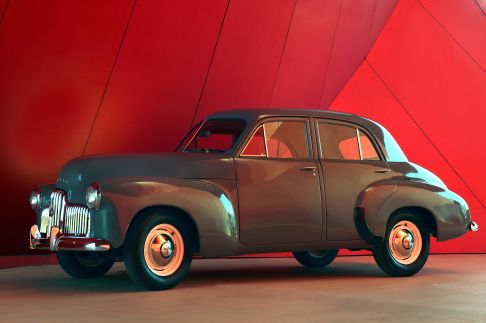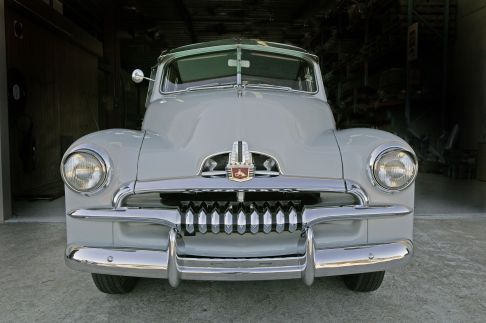
National Museum of Australia Recent acquisitions
Below you will find some of the objects the Museum has recently acquired.
Holden Prototype Car No. 1, 1946

Holden Prototype Car No. 1 Photo: Dragi Markovic
This was the first definitive model of the Holden 48-215 that launched the Australian car manufacturing industry.
Hand-construction of the car was completed by Fisher Bodies Experimental Build Shop at Detroit in August 1946 and shipped to Australia in December. Engineering and durability tests in the United States and Australia resulted in several modifications to the original design before the first Holden sedans were released for sale in February 1949.
Prototype No.1, with a replacement engine, was sold to General Motors-Holden’s works foreman Arthur Ling, in February 1952. Ling later sold it to his brother-in-law Bill Vickery who in 1956 traded it to Kelly Brothers of Morwell, Victoria. Des Kelly sold the vehicle to Gavin and Graeme Strongman who restored it to exacting standards in 1999-2000. It was then bought by Ian Metherall, who united it with the ‘Essington Lewis’ Holden.
The Strongmans’ meticulous restoration retained the original hand-built body shell and utilised the earliest available original components. The general appearance of the vehicle is close to that when it was used as a test vehicle.
Purchased with the assistance of the National Cultural Heritage Account.
Essington Lewis’ Holden 48-215

Essington Lewis’ Holden – Photo: Dragi Markovic
The first Holden car officially rolled off the General Motors-Holden’s assembly line at Fishermen’s Bend, Victoria, on 29 November 1948, opening a new era in Australian motoring. Holden vehicles, starting with the 48-215 (popularly known as the FX), quickly became an Australian institution and by 1958 could claim 43 per cent of car sales in Australia. A million had been sold by 1960.
This first FX commercially sold was delivered to the home of Essington Lewis (1881-1961), managing director of BHP, on the evening of 24 February 1949. Lewis had given crucial help to the Australian car project from its inception during the Second World War . The car was later sold to the manager of the Lewis property near Tallarook, Victoria, and then to a local rabbiter.
Having fallen into disuse it was subsequently salvaged by Mary Munckton, daughter of Essington Lewis. Ian Metherall arranged for it to be restored in 1987.
Donated by Mary Munckton and Ian Metherall
FJ Holden, 1955

The FJ grille quickly became one of Australia’s most recognisable automotive symbols. Albert Neuss Collection, Photo: Dragi Markovic
An Aussie icon finds a home in the National Historical Collection
One owner – a little old lady who only drove it to the shops and back. This could describe the National Museum’s most recently acquired motor vehicle, a rare unrestored and functional FJ Holden.
The Holden Special Sedan was built in July 1955 and purchased new from Beazley & Bruce, Canberra, by Molly Goodall of Tharwa.
Molly took great care of her new Holden. Not only would she garage it a night but she would also cover it with a horse-blanket and a rabbit-skin rug. The car was mostly driven from Rueon, the family’s sheep farm at The Angle, into Queanbeyan until it became too difficult for Molly to see out the rear of the vehicle.
Molly Goodall died on 3 June 1989 and was buried in the Tharwa Road Lawn Cemetery at Queanbeyan.
The FJ was sold to Albert Neuss sometime in the 1980s. Albert’s association with the vehicle, however, dates back to 1955 when he performed the first service on it at Esmonds Motors, a subsidiary of Beazley & Bruce. Albert rarely drove it, as he wanted to keep the miles down. The only changes he made to the vehicle were a partial paint respray and the installation of indicator lights.
Albert sold the vehicle to the National Museum in December 2003.
The FJ Holden, ‘Australia’s Own Car’, was released in 1953 and quickly became a ‘dinky-di Australian icon’. Produced locally, it sold in large numbers and was the first car that many ‘ordinary’ Australians had ever owned. The FJ was essentially a revamped version of the earlier 48-215 (commonly known as the FX) model and came in Standard, Business, Special, Utility and Panel Van versions. A million had been sold by 1960 and, despite market competition from the Ford Falcon, another million was sold over the next six years. Other Holden motor vehicle items in the National Historical Collection include four original factory design drawings and a billboard advertising ‘the beautiful HOLDEN Australia’s Own Car’.
Courtesy of National Museum of Australia website http://www.nma.gov.au/collections/recent_acquisitions/
